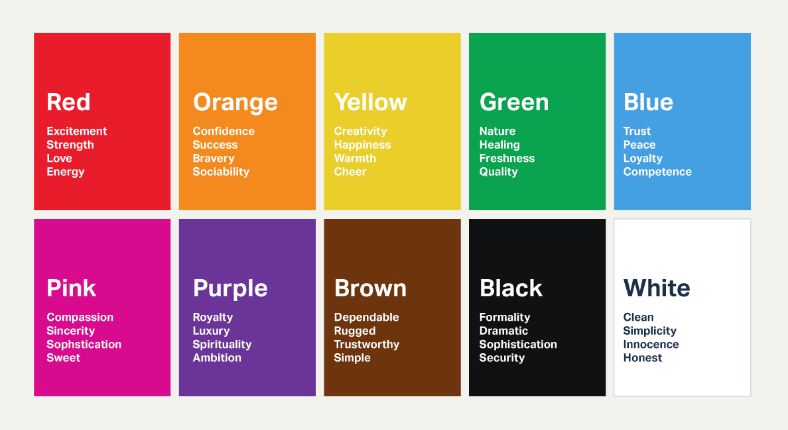The strategic use of color in marketing can profoundly influence consumer perceptions, emotions, and ultimately, their purchasing decisions.
This guide explores the facets of color psychology in marketing, with extended explanations and real-life examples, including an overview of the most commonly used colors in marketing.

1. The Science of Colors in Consumer Decisions
The psychology behind color choices can dramatically influence consumer behavior, with colors impacting up to 90% of an initial impression.
For instance, Coca-Cola’s red branding leverages the color’s associations with excitement, appetite, and passion.
This strategic choice not only aids in the brand’s global recognition but also fosters a deep emotional connection with consumers, encouraging loyalty and repeat purchases.
2. Emotional and Psychological Influences
Colors elicit specific emotional and psychological responses that brands can harness to influence consumer perception.
Facebook and Twitter’s use of blue exemplifies how colors can promote feelings of trust and security, critical in platforms where personal information is shared.
This deliberate choice supports a user-friendly environment, increasing daily user engagement and trust in the brand.
3. Brand Identity and Recall
The strategic use of color enhances brand identity and recall, setting brands apart in a crowded marketplace.
Tiffany & Co.’s distinctive robin’s egg blue packaging evokes exclusivity and luxury.
This color not only differentiates the brand but also creates an emotional bond with consumers, who associate the unique shade with quality and desirability.

4. Digital Marketing Dynamics
In the digital landscape, the psychology of color is pivotal in user interface design and engagement.
Spotify’s use of vibrant green for its CTA buttons highlights how color can draw attention and guide user actions.
This approach enhances the user experience, leading to higher engagement levels and promoting user actions such as subscriptions or content interaction.
5. Beyond Aesthetics : The Meaning of Colors
The choice of color in branding conveys a brand’s values and mission.
Whole Foods Market’s use of green in its branding and stores aligns with its commitment to health and sustainability.
This intentional use of color not only communicates the brand’s core values but also attracts a like-minded consumer base, fostering a community around shared principles.
6. Impact on Consumer Behavior
Colors have the power to influence consumer behavior and decision-making processes.
McDonald’s iconic red and yellow color scheme is engineered to grab attention and stimulate appetite.
This combination not only increases brand visibility but also accelerates the decision-making process, encouraging quicker and more frequent visits.
7. Color Associations
The association of specific colors with certain qualities can reinforce brand messaging and consumer expectations.
UPS’s use of brown signifies reliability and stability, key attributes for a delivery service.
This color choice is instrumental in building consumer trust and highlighting the brand’s commitment to dependable service.

8. Cultural Differences
Color perception can vary significantly across cultures, affecting brand strategy in international markets.
Apple’s use of white packaging, while symbolizing simplicity and elegance in Western cultures, is adapted in different cultural contexts to maintain its appeal and relevance, showcasing the brand’s sensitivity and adaptability to diverse consumer perceptions.
9. Memory and Cognition
Color can enhance memory and information retention.
The distinctive yellow border of National Geographic magazines is not only iconic but also aids in brand recognition and recall.
This strategic use of color makes content more engaging and memorable, solidifying the publication’s presence in readers’ minds.
10. Emotional Response
The emotional response elicited by colors can directly influence consumer behavior.
Target’s use of red in its branding creates a sense of excitement and urgency among shoppers, making the shopping experience more engaging and potentially increasing purchase rates.
This demonstrates how colors can be used to shape the shopping environment and consumer behavior.
11. Brand Identity and Recognition
Contrast and simplicity in color choice can significantly contribute to brand identity.
Nike’s minimalist black and white logo conveys sophistication, appealing to a broad audience.
This stark contrast ensures high visibility and recognition, supporting Nike’s brand positioning as a leader in sportswear.
12. Most Commonly Used Colors in Marketing
In marketing, certain colors are favored for their universal appeal and psychological impact.
Red, known for its ability to attract attention and evoke excitement, is widely used in call-to-action buttons and sale announcements.
Blue, symbolizing trust and reliability, is preferred by financial institutions and social media platforms.
Green is associated with health, tranquility, and the environment, making it a popular choice for organic and eco-friendly brands.

Each of these colors has specific connotations that marketers leverage to align with their brand identity and target audience’s expectations.
Integrating color psychology into marketing strategies allows brands to communicate more effectively with their audience, leveraging the emotional and psychological impacts of colors to enhance brand identity, influence consumer behavior, and drive successful marketing outcomes.
